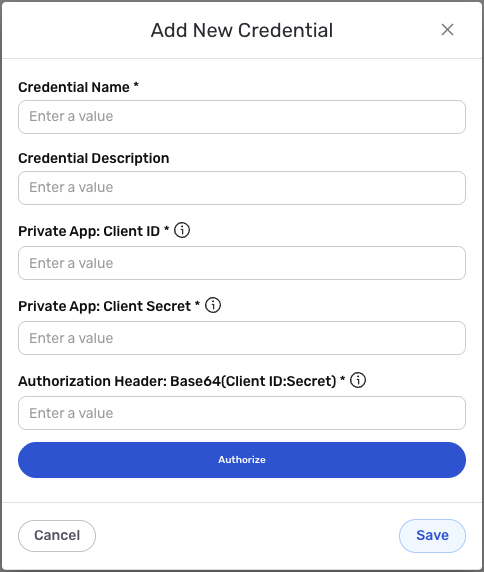Authorization

RingCentral
Prerequisites
Before creating a RingCentral credential, you need to obtain your OAuth2 Client ID and Client Secret from your RingCentral account. RingCentral uses OAuth2 3-legged authentication, which requires user authorization to access your RingCentral account.
To obtain your RingCentral OAuth2 credentials, follow these steps:
-
Sign in to your RingCentral account using your administrator credentials.
-
Navigate to the RingCentral Developer Portal at https://developer.ringcentral.com and sign in with your RingCentral account.
-
Navigate to Apps or My Apps in the developer portal to view your applications.
-
If you don't have an application yet, click Create App or New App to create a new application.
-
Configure your application settings:
- Enter a name for the application (e.g., "Nexla Integration")
- Select Private as the application type (for server-to-server authentication)
- Review and select the permissions or scopes for the application (if applicable)
-
Click Create or Save to create the application.
-
Your Client ID will be displayed on the application details page. Copy the Client ID.
-
Your Client Secret will be displayed on the application details page. Copy the Client Secret immediately, as it may not be accessible again after you navigate away from the page.
-
Store both credentials securely, as you will need them to configure your Nexla credential. The Client ID and Client Secret are sensitive information and should be kept confidential.
The Client ID and Client Secret are used to authenticate with the RingCentral API authentication endpoint (/oauth/token) to obtain an access token. The access token is then sent in the Authorization header with the Bearer prefix for all subsequent API requests to the RingCentral API. The access token is automatically obtained and refreshed by Nexla as needed. If your credentials are compromised, you should immediately revoke them in your RingCentral developer portal and generate new ones. For detailed information about RingCentral OAuth2 authentication, API access, and available endpoints, refer to the RingCentral API documentation.
Create a RingCentral Credential
- To create a new RingCentral credential, after selecting the data source/destination type, click the Add Credential tile to open the Add New Credential overlay.
New Credential Overlay – RingCentral

Credential Name & Description
-
Enter a name for the credential in the Credential Name field and a short, meaningful description in the Credential Description field.
Resource descriptions are recommended but are not required. They should be used provide information about the resource purpose, data freshness, etc. that can help the owner and other users efficiently understand and utilize the resource.
OAuth2 3-Legged Authentication
RingCentral uses OAuth2 3-legged authentication for all API requests. Your Client ID and Client Secret are used to authenticate with the RingCentral API authentication endpoint to obtain an access token, which is then used for all subsequent API requests.
-
Enter your RingCentral Client ID in the Private App: Client ID field. This is the Client ID you obtained from your RingCentral developer portal (Apps > Your App > Client ID). The Client ID is used along with the Client Secret to authenticate with the RingCentral API authentication endpoint and obtain an access token.
-
Enter your RingCentral Client Secret in the Private App: Client Secret field. This is the Client Secret you obtained from your RingCentral developer portal. The Client Secret is used along with the Client ID to authenticate with the RingCentral API authentication endpoint and obtain an access token. The Client Secret is sensitive information and must be kept confidential.
-
Click the Authorize button to begin the OAuth2 authorization flow. You will be redirected to the RingCentral authorization page where you will need to sign in and grant permissions to Nexla to access your RingCentral account.
-
After granting permissions, you will be redirected back to Nexla, and the authorization will be completed automatically. The access token and refresh token will be stored securely in your credential.
Your RingCentral OAuth2 credentials can be found in your RingCentral developer portal under Apps > Your App. The Client ID and Client Secret are used to authenticate with the RingCentral API authentication endpoint (
/oauth/token) to obtain an access token. The access token is then automatically sent in theAuthorization: Bearer {token}header for all subsequent API requests to the RingCentral API.The access token is automatically obtained and refreshed by Nexla as needed. If your credentials are compromised, you should immediately revoke them in your RingCentral developer portal and generate new ones. The Client ID and Client Secret provide access to your RingCentral account data and should be treated as sensitive information. Keep your credentials secure and do not share them publicly.
For detailed information about RingCentral OAuth2 authentication, API access, and available endpoints, see the RingCentral API documentation.
Save the Credential
-
Once all of the relevant steps in the above sections have been completed, click the Save button at the bottom of the overlay to save the configured credential.
-
The newly added credential will now appear in a tile on the Authenticate screen during data source/destination creation and can be selected for use with a new data source or destination.